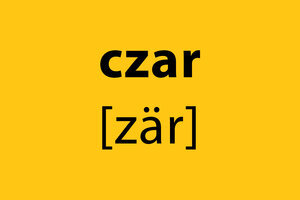Need a point person? Appoint a czar.
How did czar, royal title of the rulers of Russia until 1917, become so prevalent in the United States?

Staff
A few weeks ago, the media reported that President Donald Trump had chosen Vice President Mike Pence as “coronavirus czar,” putting him in charge of the country’s response to the COVID-19 outbreak. Mr. Trump has been relatively abstemious in appointing czars, but former Presidents Barack Obama and George W. Bush each had more than 30 of them. How did czar, royal title of the rulers of Russia until 1917, become so prevalent in the United States?
Today the word means “a person appointed by government to advise on and coordinate policy in a particular area,” according to Dictionary.com, but its first English uses referred to the Russian rulers. Travelogues in the 16th century present “the czar” as an exotic figure, an autocrat in a fur hat. As the word’s etymology suggests, it comes from caesar, “emperor” to the ancient Romans. The original czars were powerful, sometimes absolute, monarchs.
The first American to be dubbed “czar” was apparently Nicholas Biddle in the 1830s, and this was not meant as a compliment. Biddle presided over the federal bank, which President Andrew Jackson wanted to abolish. To stir up resentment against him, Jackson’s allies called him Czar Nicholas, implying that he directed the bank according to his own whims.
Czar kept this connotation of despotism and tyranny until the Russian Revolution, when it quite suddenly developed a kinder, gentler – or perhaps simply ironic – sense. As soon as the actual czars were no more, czars galore appeared in the U.S. Looking at newspapers in the 1920s, it seems as if every organization had one. There were czars of baseball, poultry, milk, and so on. Two factors seem to have driven this rise. First, it is a media-friendly word. It’s catchy and short, a plus for newspaper headlines. “TARP czar” takes up a lot less room than “assistant secretary to the Treasury for financial stability, in charge of the Troubled Assets Relief Program.”
Second, as government bureaucracy has expanded, presidents have needed people who can take a global view of a situation and cut through red tape: the czar. During World War II, for example, President Franklin Roosevelt appointed a number of them to make sure that both the military and civilian sides of the economy had access to the resources they needed. The “rubber czar,” for example, allocated rubber so that there was enough to make tires for the military as well as shoes for civilian factory workers.
Today the word’s history is catching up with it. Many politicians on both sides of the aisle are newly uncomfortable with the term’s Russian connections and tyrannical connotations, especially since czars can be appointed without Senate confirmation.

